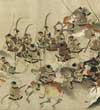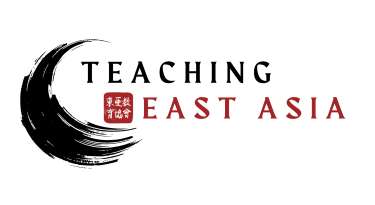Imaging Japanese History:
A Case Study of Medieval Japan through Art: Samurai Life in Medieval Japan - Lesson


Essay
Lesson
M1 Handout
M2 Print Handout
M2 Online Handout
by Jaye Zola, Retired Teacher and Librarian, Boulder Valley Schools
Print PDF
Introduction:
Teachers are encouraged to read “Medieval Japan: An Introductory Essay,” by historian Ethan Segal, prior to conducting this lesson. The introductory essay may also be assigned to students with advanced reading abilities (grades 11-12). The essay provides context for this lesson by sketching the history of medieval Japan.
Medieval Japan saw warfare and chaos. The growth of the warrior class and the influence of Buddhism eventually gave rise to a refined culture having roots in the classical Japanese tradition.
The time period referred to as medieval Japan actually comprised three distinct periods: the Kamakura (1185-1333), Muromachi (1336-1573), and Momoyama (1568-1603). Beginning with the Kamakura through the mid-19th century, military rulers governed Japan. During the Muromachi and Momoyama, the feudal structure concentrated wealth, culture, and power in the hands of feudal lords called daimyō. The social structure of samurai as retainers to noble lords enabled a few powerful daimyō to eventually be shogun or the military ruler.
This lesson is designed to challenge the view of sword-wielding samurai of U.S. movies. Rather than focusing on one particular art form, this lesson uses a variety of images from scrolls, screens, and artifacts. Using these visual sources, students learn about the three different periods of medieval Japan. Adding to the visual record of this time period, literature selections bring the voice of the samurai into the historical account. Students use art and literature to deepen their understanding of warrior life, looking at the importance of cultural and religious traditions to the daily life of daimyō and samurai and expanding their knowledge of medieval Japan.
Objectives: At the conclusion of this lesson, students will be better able to:
- Explain the rise of military government of medieval Japan.
- Describe the life of the warrior class.
- Interpret a primary source document.
- Use pictorial evidence to create and support a project.
- Demonstrate visual literacy by analyzing a work of art within its original historical, political, economic, religious, or social context.
Vocabulary:
- daimyō: the most powerful feudal rulers, often called warlords
- samurai: the warrior class who fought for the daimyō
- shogun: military ruler
- shugo: early military governors of provinces in Kamakura period
- Kamakura period: the time span marking the start of the medieval period and the years of Japan’s first warrior government, the Kamakura bakufu (1185-1333)
- Muromachi period: the time span marking the years of Japan’s second warrior government, the Muromachi bakufu (also called the Ashikaga bakufu) (1336-1573)
- Momoyama period: the final years of the medieval period; also known as the Azuchi-Momoyama period (1568-1603)
Materials and Advance Preparation:
The easiest way to provide access to the sources used in the lesson is to have students work directly with the M2 Online Handout on Internet-equipped computers. If it is not feasible, print out the images and post them around the room or at tables where groups can examine them. The images you will need are:
- The Heiji Monogatari Emaki
- The Battles of Ichinotani and Yashima screen
- Images of current bows made to copy those of the past:
- View of a warrior fighting the Mongols, from Suenaga's Mongol Invasion scrolls
- Golden Pavilion
- Silver Pavilion or Ginkakuji
- Other Japanese rock gardens
- Noh theater images:
- Hideyoshi’s gold tearoom
- Tearoom layout
- A tea bowl
- A bamboo tea spoon
- A water jar
- Himeji Castle
- Momoyama period armor
Make copies of the M1 Handout for all students. Write in the focus time periods on the handout; approximately one-third of the class should focus on each period—Kamakura, Muromachi, and Momoyama. Also copy the version of M2 Print Handout for student use if you are not having students use the online version.
Time Required: 2 class periods
Procedure:
- Introduce the activity by explaining that students will be using art as a primary source to learn about life in medieval Japan. Students will use this pictorial evidence to develop an understanding about the historical, political, and religious life of the warrior class including samurai, daimyō, and shogun. If necessary, define the three different groups.
- Explain that Japan has exported many cultural products to the United States. Ask students what comes to mind when they think of contemporary influences of Japan on U.S. culture. Students might mention Hello Kitty, Pokémon, Harajuku fashions, sushi, anime, manga, J-pop, electronics, and cars. Discuss briefly why students think these Japanese exports are popular in the United States.
- Mention that not all of these exports are viewed the same way in Japan as they are here. In particular, the image of the samurai has been used in many U.S. films in a very simplified interpretation. Ask students: What movies or video games have you seen or played that give you your image of samurai? (Students might mention Kill Bill, The Last Samurai, Samurai Warriors, and other video games.) Ask students to brainstorm all the words and images that come to mind when they hear the word samurai. What are our popular notions of a samurai? (Answers will vary; some words students may mention are brave, loyal, swords, seppuku [ritual suicide, also known as hara-kiri], honor, ready to die.) Post the list to refer to at the end of the lesson. Explain that this activity will get them to look beyond the stereotype, as well as understand the role of samurai, daimyō, and shogun in medieval Japanese history.
- Divide the class into three groups: Kamakura, Muromachi, and Momoyama. Students can research together or individually. Give each student a copy of the M1 Handout, which explains what students are to do with the historical information, art, and literature they read as they work through the M2 Handout. Make sure students understand their role as a historical expert on one of the periods in medieval Japan. They will have the entire handout and should go through the information on the other periods; it will help them understand their assigned period and how it differed from the others. However, they will only answer the questions and report on the one period assigned to them—Kamakura, Muromachi, or Momoyama. Review the instructions and ask for any clarification. Students will report out on Day 2 so everyone will learn about the different time periods.
- If students can access the M2 Handout online and link to the websites as they read, that would be the most expedient way to access the art and literature. If not, point out where the sources referenced in the handout can be found in the classroom. Allow the rest of the class period for students to read and look at the images individually or in pairs.
- On Day 2, group students who focused on the same time period so the class can identify what periods are being discussed. Begin the reporting on each period (Kamakura, Muromachi, and Momoyama) by sampling different students’ responses to the questions, comparing differences and sharing similiarities. Ask students about what changed in their historical knowledge of samurai and daimyō. In discussing the two later periods, have students identify how life of the samurai and daimyō changed from previous periods. Debrief common themes and subjects. (Students should notice the increasing power and wealth of samurai, daimyō, the growth of Buddhism and its influence on the culture.)
- Refer to the initial brainstormed list of associations of the word samurai. Ask: What do you know now that you didn’t know before doing this activity? Ask students to review the different periods within medieval Japan and explain the changes of the role of samurai, daimyō, and shogun over the 400 years.
- Conclude by asking students why they think Hollywood and U.S. culture simplify the samurai rather than depicting the changing role across history. Have students explain their reasoning.
Assessment:
Students’ responses to the M1 Handout can be used as an assessment.
Extension/Enrichment:
Japanese movies portray samurai in different ways and could be used to add perspective, acknowledging, of course, that these fiction films appeal to contemporary audiences. Some recommendations are Duel at Ichijoji Temple, Musashi Miyamoto, Yojimbo, Sanjūrō, Seven Samurai, Rashōmon, and Kagemusha.
A field trip to an art museum with Japanese artifacts would be beneficial to see the art, armor, and religious relics from this time period.
If the teacher would like to add a literature component to the activity, students could create a waka about the samurai or daimyō to share with the class. A waka is a Japanese poem of 31 syllables, arranged in five lines, of 5/7/5/7/7 syllables respectively. Below are two examples. Note that in translating from Japanese, the syllable count changes:
koma tomete
sode uchiharau
kage mo nashi
sano no watari no
yuki no yugureHalting my mount
To brush my sleeves,
I cast no shadow
At the ford of Sano,
Snow falling in the evening.Fujiwara no Teika, Shinkokinshū, vol. VI: 671
toko no shimo
makura no kōri
kie wabinu
musubi mo okanu
hito no chigiri niWith frostfall upon my bed,
The ice upon my pillow
Cannot melt away - I lack the strength to die
Leaving unfulfilled
The vow I made to you.Fujiwara no Teika, Shinkokinshū, vol. XII: 1137
From Waka for Japan, Thomas McAuley, trans. (Sheffield, UK: School of East Asian Studies, University of Sheffield, 2001).
Teacher Resources:
Friday, Karl F., Samurai, Warfare and the State in Early Medieval Japan (New York: Routledge, 2004).
Sadao, Tsuneko S., and Stephanie Wada, Discovering the Arts of Japan: A Historical Overview (Tokyo: Kodansha International, 2003).
Shimizu, Yoshiaki, ed., Japan: The Shaping of Daimyo Culture 1185-1868 (Washington, DC: National Gallery of Art, 1988).
Varley, H. Paul, Ivan Morris, and Nobuko Morris, Samurai (New York, Delacourt Press, 1970).
Varley, H. Paul, Warriors of Japan as Portrayed in the War Tales (Honolulu: University of Hawaii Press, 1994).
Created © 2008 Program for Teaching East Asia, University of Colorado.

Imaging Japanese History
- A Case Study of Heian Japan through Art: Japan's Four Great Emaki
- A Case Study of Medieval Japan through Art: Samurai Life in Medieval Japan
- A Case Study of Tokugawa Japan through Art: Views of a Society in Transformation
- Becoming Modern: Early 20th Century Japan through Primary Sources
- A Case Study of Late Twentieth-Century Japan through Art: Tezuka Osamu and Astro Boy

